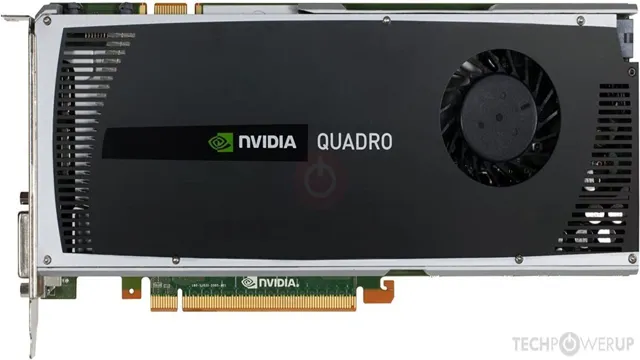If you’re someone who spends a lot of time on their computer, you know the importance of having a good graphics card. It’s what allows you to see beautiful images, play games without lagging, and create stunning visual art. One graphics card that has been popularized in recent years is the Intel HD Graphics 4000.
This little powerhouse is found in many laptops and desktops, and it’s known for its ability to handle basic graphics needs without breaking the bank. But is it really worth the hype? Let’s dive deeper into the world of the Intel HD Graphics 4000 and find out.
What is Intel HD Graphics 4000?
If you’re looking for an affordable graphics card for your gaming needs, you might have come across the Intel HD Graphics 4000. So, what exactly is it? Well, it’s an integrated graphics card that comes built-in with the processor, designed for laptops and desktops. While integrated graphics cards aren’t as powerful as dedicated ones, the Intel HD Graphics 4000 delivers decent performance for everyday tasks and light gaming.
It’s capable of running games like FIFA 17, League of Legends, and Minecraft, albeit on lower settings. The card supports DirectX 11 and OpenGL 0, which enables advanced features like tessellation and displacement mapping.
The card also supports Intel’s Quick Sync Video technology which improves video playback and encoding performance. If you’re on a budget or don’t want to spend too much on a graphics card, the Intel HD Graphics 4000 is a good option to consider.
Features
Intel HD Graphics 4000 is an integrated graphics card that is found in various Intel processors. It was first introduced in 2012 and has been a popular choice for budget-friendly laptops and desktop systems ever since. This graphics card is designed to handle basic computing tasks and multimedia applications such as video playback, web browsing, and light gaming.
The Intel HD Graphics 4000 comes with a range of features that make it a desirable option for everyday users. For instance, it supports DirectX 11, which provides enhanced 3D graphics and improved visual effects. It also comes with Quick Sync video, which enables faster video encoding and decoding.
Moreover, it supports multiple display connections, allowing users to connect their laptop or PC to multiple monitors. Overall, Intel HD Graphics 4000 is a reliable and efficient graphics card that delivers satisfactory performance for everyday computing needs.

Performance
Intel HD Graphics 4000 is an integrated graphics card that was released in 2012 and commonly found on Intel’s third-generation Ivy Bridge CPUs. This graphics solution provides on-board graphics that can be used in conjunction with a separate graphics card or as a standalone graphics solution for basic computing needs. The HD Graphics 4000 has 16 execution units and a maximum dynamic frequency of 1150 MHz, enabling it to handle basic operations such as browsing the web, playing video, and editing photos.
However, its performance may struggle when trying to run more demanding applications or games. The HD Graphics 4000 also supports DirectX 11 and OpenGL 0, and has a maximum output resolution of 2560×1600 at 60 Hz.
Overall, the HD Graphics 4000 is a decent on-board graphics solution for everyday computer use, but it may lack the power and performance required for more intensive tasks.
Applications
If you are using a card with Intel HD graphics 4000, you might wonder what applications you can run with it. This graphics card may not be the latest one on the market, but it is still capable of running many popular applications. For example, you can use it for most office applications, such as Microsoft Word, Excel, and PowerPoint.
It also supports web browsing and video playback, so you can watch your favorite shows and movies without any lag or stuttering. Gamers might be disappointed by the fact that this graphics card cannot run the latest games at high settings, but it can run some older games at lower settings. Overall, Intel HD graphics 4000 is a decent graphics card for everyday use, but if you want to play the latest games or use more demanding applications, you might want to consider upgrading to a more powerful card.
Gaming
When we talk about gaming, there are a lot of applications out there that can make the experience even more enjoyable and entertaining. From streaming and recording software to in-game overlays and customization tools, the possibilities are endless. One of the most popular gaming applications is Discord, which allows players to communicate with each other while gaming, share screens and even play games together.
Another great application is OBS (Open Broadcaster Software), which is used for live streaming or recording gameplay footage. This application is very versatile and can be used for different platforms, including Twitch, YouTube, and Facebook. Gamers can also benefit from using a customization application like Rainmeter, which allows them to personalize their desktops and add various widgets and plugins to enhance their gaming experience.
The right applications can take the gaming experience to the next level and provide endless opportunities for gamers to connect, customize, and share their experiences with others.
Video and Image Editing
When it comes to video and image editing applications, there are a plethora of options available in the market. From the widely popular Adobe family to the easier-to-use Canva and InShot, they cater to the needs of beginners and professionals alike. Adobe Photoshop and Illustrator are two of the most extensively used applications for editing images and are a staple for graphic designers.
Whereas Adobe Premiere Pro is a widely popular application that caters to video editing needs, it is accompanied by Adobe After Effects for special effects and motion graphics. Canva, on the other hand, is a beginner-friendly application that can be used for visual design, making social media posts, and creating presentations. Similarly, InShot is a mobile application that provides extensive features for video editing, including trimming, merging, adding music, and special effects.
While the choice of the application mainly depends on the level of expertise, it is advisable to experiment with different applications and stick to what best suits one’s needs.
General Use
When it comes to applications, the possibilities are nearly endless. Applications, or apps for short, can be used for a variety of purposes, from entertainment to productivity. Entertainment apps like games and streaming services provide a fun way to pass the time, while productivity apps like calendars and to-do lists help keep us organized.
Social media apps like Facebook and Instagram connect us with friends and family around the world, while navigation apps like Google Maps and Waze help us get where we need to go. There are also apps for education, health and fitness, finance, and more. With the ever-growing popularity of smartphones and tablets, the demand for apps continues to rise.
Developers are constantly creating new and innovative apps to meet the needs of users, making it easier than ever to find an app that’s perfect for you.
System Requirements
If you are planning to play some modern games on your laptop or desktop computer, you need to ensure that your card Intel HD Graphics 4000 is up to the task. This integrated graphics card was released in 2012 and is commonly found in older laptops or PCs. Its performance is limited and can only handle basic graphics tasks like watching videos, browsing the web or working with documents.
If you want to play games or run graphic intensive applications, you will require a dedicated graphics card. Good dedicated graphics cards can be expensive, but they offer better performance and can handle the most demanding games and applications. Before you buy a new graphics card, make sure that your computer’s power supply can support it and that you have the necessary space in your computer case to install it.
Also, note that the performance of your graphics card may be limited by other factors in your computer such as the processor and the amount of RAM. So before upgrading your graphics card, check if your computer can support it and if it can handle the additional workload.
Minimum Requirements
When it comes to running any kind of software or program, it’s always important to make sure your system meets the minimum requirements. This ensures that the software will function as intended and won’t cause any performance issues or crashes. For example, if you’re planning on installing a new game on your computer, you’ll want to check the system requirements listed on the game’s packaging or website.
These requirements typically include information on the necessary operating system, processor, RAM, graphics card, and storage space. It’s important to keep in mind that just meeting the minimum requirements may not provide the best experience, as more demanding software can require more advanced hardware. But, at the very least, meeting the minimum requirements is a good starting point.
So before you install any new software, make sure to check the requirements first to avoid any potential headaches down the road.
Optimal Specifications
When it comes to software development, having optimal PC specifications is crucial for smooth and efficient operation. The requirements may vary depending on the specific software, but there are some common elements to consider. Firstly, having a powerful processor with multiple cores is ideal for simultaneous handling of complex tasks.
Additionally, having ample RAM capacity is essential to avoid lagging or freezing during intensive usage periods. The graphics card should also be able to deliver high-quality visual output, especially in applications that require 3D rendering or video processing. Lastly, having a high-speed solid-state drive (SSD) is critical for quick and responsive loading times.
Overall, investing in optimal PC specifications translates to improved performance and productivity in software development.
Final Thoughts
When it comes to graphics in computers, the Intel HD Graphics 4000 is a popular choice for those who are not into high-end gaming or graphic designing. This graphics card is integrated into many laptops and desktops, making it a reliable option for everyday use. With its 16 execution units and clock speed of up to 1350 MHz, the HD Graphics 4000 can handle basic tasks such as video playback, web browsing, and office work with ease.
However, if you plan on doing some editing or gaming, it may struggle to keep up with the demands. But overall, it’s a decent option for those who need a basic and reliable graphics card.
Conclusion
The Intel HD Graphics 4000 may not be the flashiest or most powerful graphics card out there, but it’s like the dependable friend you always count on. It may not impress you with its looks, but it delivers solid performance that you can rely on every time. So, if you’re looking for a trustworthy companion to get you through your gaming or work needs, the Intel HD Graphics 4000 is your guy.
Don’t underestimate the underdog.”
FAQs
What is the maximum resolution supported by the Intel HD Graphics 4000 card?
The Intel HD Graphics 4000 card supports a maximum resolution of 2560 x 1600 pixels.
Is the Intel HD Graphics 4000 card suitable for gaming?
While the Intel HD Graphics 4000 card is capable of running some games, it is not recommended for high-end gaming as it may not be able to handle heavy graphics.
How much video memory does the Intel HD Graphics 4000 card have?
The Intel HD Graphics 4000 card does not have any dedicated video memory, but it shares the system’s RAM for graphic processes.
Can the Intel HD Graphics 4000 card support multiple displays?
Yes, the Intel HD Graphics 4000 card can support up to three displays simultaneously. However, the maximum resolution and refresh rate may vary depending on the system’s configuration.


